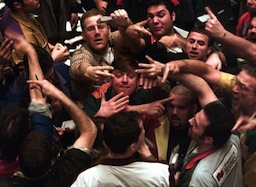I see Halifax, the bank that brought us Howard the singing clerk – and brought to its shotgun suitor Lloyds a load of duff Irish property loans – is now offering spread betting.
Previously, spread betting has been the preserve of companies like IG Index and City Index. Large firms, sure, but hardly household names.
As I write, Halifax is devoting a key spot in its share dealing home page to promoting its spread betting product. I don’t know how many share dealing customers Halifax has, but its service – which I use and like – has regularly won awards, and given the size of the parent I’d imagine it’s significant.
I think we can therefore say that spread betting has hit the mainstream.
What is spread betting?
When you spread bet on a company’s shares, you speculate that their price will go up or down.
The more the price rises or falls in line with your bet, the more money you make – and vice versa.
Invariably spread betting firms enable you to ‘gear up’ your position if you want, so the same amount of money can go further than if you had bought (or sold) shares in the firm the traditional way.
- This increases the potential reward you make from a correct bet, without the need for more money.
- But it also greatly increases the risk, since you can easily lose more than your initial deposit if your bet goes wrong.
You don’t explicitly pay commission when you spread bet, but to cover its costs and make a profit, a spread betting firm defines a price ‘spread’ that the share price must move above or below before your bet begins to pay out.
The chief benefit of spread betting – besides the ability to borrow to bet on shares, for those who want that – is that spread betting gains in the UK are currently free of capital gains tax.
What then is ‘spread trading’?
You won’t find the words ‘spread betting’ featured prominently on Halifax’s site.
Instead, the company calls its new service ‘spread trading’, rather than ‘spread betting’.
The bank might argue that it’s a more understandable term for its customers. But I’d cough and suggest ‘trading’ is probably also a rather more respectable-sounding term for a bank to be associated with than ‘betting’.
The Inland Revenue isn’t confused, though. Spread betting is exempt from Capital Gains Tax precisely because it’s judged to be gambling, not investing.
Presumably Halifax ran the term ‘spread trading’ by the authorities before launching its service. But it will still be interesting to see what name it uses in the long-term.
There may even be existing spread betters who would be drawn to opening an account with a financial giant like Halifax.
It’s important to note, though, that Halifax’s spread betting service is provided by City Index – and I presume it runs a version of that company’s own platform.
More importantly, the bank also states that: “Halifax Spread Trading is provided by City Index Ltd and therefore your contractual relationship is with City Index.”
Risky business
Halifax is also offering the same encouragement you see in most adverts for spread betting in the media: free credit to get new customers started.
It’s widely quoted that something like 80% of spread betters lose money, so I’ve always presumed the credit offers were there to hook people into the habit.
But perhaps the bank will be spinning its £100 of free credit as more of an introductory bonus type affair.
To give Halifax its due, the bank does state very clearly and multiple times that spread betting is not for everyone.
The website frequently states it is “for the more experienced trader”.
The bank also states prominently on its “What is spread trading?” page beneath ‘Understand the risks’ that:
Spread Trading is a high risk product. Please remember that it’s possible to quickly lose substantially more than your initial deposit and you may be required to make further deposits at short notice to maintain open positions. Spread Trading is not for everyone so please ensure you understand the risks.
The follow-up page on those risks is pretty clear, too:
Halifax Spread Trading is a product which you can use to speculate on the price movement of an investment, whether it’s rising or falling. It is important to remember that Spread Trading is designed for experienced traders and carries a high level of risk to your capital. You should only trade with money you can afford to lose. It is possible to quickly lose substantially more money than your initial deposit.
There then follows a long list of the various things that can go wrong with this type of service.
I haven’t signed up for this service, so don’t know if any vetting is applied to ensure only “experienced traders” are given accounts.
When I opened a spread betting account with a different firm in the past, the chief requirement appeared to be a credit card.
What would you bet on?
I am not adamantly anti-spread betting, unlike many old school investors.
Back in the good old days when making big capital gains was still a problem (little joke), experienced investors with fairly large portfolios could use spread betting accounts to avoid accruing taxable gains, even while running fairly traditional portfolios – as opposed to the typical day trader betting on the value of the FTSE.
Properly explaining how they do this would require an article in itself!
But to simplify, you take small, leveraged positions of the companies you want to hold in your portfolio in your spread betting account, and keep the bulk of your money in cash to offset the ongoing costs of leveraging up your positions.
You must also have cash available to meet margin calls.
Like this, you can theoretically replicate how a ‘normal’ portfolio of shares would rise and fall, without incurring a tax gain (or loss) – although at today’s low cash deposit rates I think it would be difficult to offset all the costs of borrowing.
But I don’t think this is how most spread betters behave.
Rather, they make short-term bets on anything from the gold price to the Dow Jones Industrial Average to the price of Shell to how many runs England will make in their next Test Match.
And they leverage up those positions without a cash reserve, which means they are wiped out by small moves against them.
It is therefore probably only a matter of time before a tabloid paper finds someone made into a pauper by spread betting and publishes a “Should our taxpayer-owned bank be supporting this gambling?” type story.
That might be unfair, like most tabloid sensationalism.
Yet I would question whether this is really a sensible product for a mainstream bank to be getting into.
Average investor: Not a hedge fund genius
Another thing to consider is what the evident appetite for spread betting tells us about the psychology of investors today.
It seems you can hardly open an investing magazine or newspaper without finding an ad or pullout supplement for one of the big spread betting firms.
The ability to go short (i.e. bet against) companies and the indices seems to be very appealing to the many who are sick of losing money as the markets bounce around.
But remember, the average investor is very poor at timing the market.
Therefore, as with so much else since 2008/2009, I see this evident desire to short the market as probably a pretty bullish contrarian indicator, suggesting that markets are more likely to go up than down from here.




